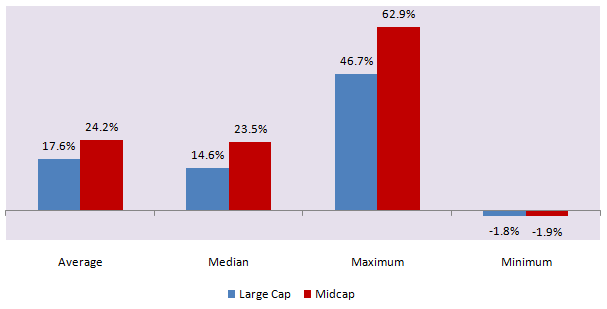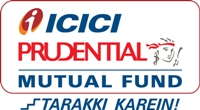5 Myths you need to know about Mid Cap and Small Cap Funds

Generally, stocks are classified into large-cap, mid-cap, and small-cap based on their current market capitalization. The term 'Market capitalization' with reference to a company is the total number of its outstanding shares in the market multiplied by the current price per share. With market capitalization, investors get an estimated valuation of the company.
Large-cap stocks are large, well-established companies which are considered relatively “safe” and have market leadership in their respective industry segments. As per SEBI market cap definitions, the top 100 companies by market cap are classified as large cap companies. Mid-cap stocks are mid-sized companies, which have achieved scale but are smaller in size (market share, revenues, profits etc) than large cap companies.
As per SEBI market cap definitions, the 101st to 250th companies by market cap are classified as mid cap companies. Small cap companies are the ones which are in either in early stages or still have not achieved scale. As per SEBI market cap definitions, companies whose market cap is smaller than the top 250 companies are classified as small cap companies. Mid cap and small cap have stock great potential for growth and can give high returns over a long investment horizon. These stocks tend to be under-researched and therefore, they are sometimes available at valuation discounts. However, in-depth research should be carried out before investing in such stocks.
In recent years, the mid-cap and small-cap mutual funds have seen a rapid growth in Assets under Management (AUM) on the back of spectacular returns in these segments from 2014 to 2018. However midcap and small cap funds tend to be more volatile than large cap funds and this can make investors nervous about mid and small cap funds in volatile markets or corrections.
Did you know about investing in large cap funds versus mid cap mutual funds
Midcap funds saw large-scale redemptions in the financial crisis of 2008. Year to date (2018), midcap and small cap stocks have underperformed large cap stocks and although investor sentiments have remained firm, some midcap (and small cap) schemes have seen redemptions, betraying investor nervousness in these funds. Retail investor’s attitude towards some investments is often shaped by myths or incorrect perceptions, which results in investors making wrong investment decision. In this blog post, we will look at some common myths about the midcap and small cap mutual funds:
MYTH 1: Mid- and Small Caps are risky
Equity as an asset class is risky – different market cap segments and individual stocks have different risk profiles. This is where an investor requires the expertise of a fund manager, who makes investment decisions on the basis of favorable risk-return trade-offs in order to protect the investors' capital. Generally, we can say that individual midcap and small cap stocks are riskier than the large caps stocks because large cap companies enjoy the advantage of larger market presence and larger balance sheets, which plays in their favor during economic downturns.
However, not all midcap stocks can be painted with the same brush. Some midcap companies are stronger than others, have more robust business model and balance sheets. There are examples of many midcap companies who have performed even better than their large cap counterparts. Midcap funds spread the stock specific and sector specific risks by way of diversification where the funds are invested in a diversified portfolio of midcap and small cap stocks across multiple sectors. The risk of individual midcap and small stocks cannot be equated with risk of midcap or small cap mutual funds.
It is fair to say that, midcap and small cap funds are more volatile than large cap funds. Many investors tend to equate volatility with risk, but in our view these are two distinct concepts. Volatility is the daily Net Asset Value (NAV) or price fluctuation of a fund. Prices can go up or down – volatility does not distinguish between upward and downward price movement, though sharp falls can understandably be stressful for investors. Risk in our view, is the probability of making a loss. Investors should understand that they will make a loss only if they redeem (sell) – if you are holding your investment, then all profits or losses are notional. Therefore it is very important to understand, risk is tied to the investment tenure of the investor. Longer your investment tenure in equity mutual funds, lower is the risk irrespective of interim volatility. We recommend that investors should have at least 3 to 5 years of investment horizon for equity mutual funds – longer the better.
With this contextual understanding of risk, let us now examine the risk and returns of large cap equity mutual funds versus midcap mutual funds for a five year holding period across all market scenarios. We looked at 5 year rolling returns of large cap versus midcap funds, assuming your holding period is 5 years, over the last 20 years (which covered all possible market scenarios) – please note that we are looking at category average returns and not fund specific returns. See the chart below.

Source: Advisorkhoj Rolling Returns Calculator
Looking at the chart, we can see that the minimum returns of large cap versus midcap funds for a five year holding period across all market scenarios (over 20 years) is almost the same – purely based on this analysis, we cannot say that midcap funds are riskier than large cap funds over a 5 year holding period.Let us now see the risk return trade-off. The average 5 year return of midcap funds across all market scenarios is much higher than that of large cap funds. Also, the highest return of midcap mutual funds is much higher than the highest return of large cap mutual funds over a 5 year holding period. This proves the notion wrong that midcaps are riskier than large caps (over a 5 year holding period) from a risk return trade-off perspective.
Read: Mutual Funds that you must have in your portfolio
MYTH 2: Mid and Small Caps are of inferior quality
Many investors believe that large cap companies are more reliable when compared to midcap and small cap since large cap companies have higher revenues, higher profits (earnings per share) and bigger balance sheets. However, investors should understand that higher revenues or profits may not necessarily imply stronger fundamentals. Thousands of Crores of revenues and profits make good newspaper headlines, but all investors care about is capital appreciation, in other words, share price appreciation. Share price appreciation is primarily driven by 3 factors – earnings per share growth (EPS), sustainability of EPS growth and finally, the price at which you buy the shares.
It is important to note that larger revenue (or profit base) does not necessarily imply higher EPS growth. High operating margins, free cash flows and high return on capital employed (ROCE) drives the EPS growth. There are many midcap companies that are often able to generate higher free cash flows and ROCE. Large cap companies tend to be more capital intensive, rely on debt financing and therefore,have high debt to equity ratios. This causes these companies to have high interest burden which eats into their profit margins and ROCE. Midcap and small cap companies tend to have less capital intensive business models and lower financial leverage (debt equity ratio). While this may cause mid and small cap companies to be size limited in the near to medium term, in the longer term, this works as an advantage for midcap and small cap companies and they are able to generate higher profit margins and ROCE.
Moreover, large caps usually trade at a premium to midcap valuations. Investing in midcaps has higher growth potential and eventually these midcaps and smallcaps can fetch higher returns for investors during valuation re-rating (upgrade) resulting in high EPS growth. This gives another reason why the midcap funds have outperformed large caps over a long investment horizon. The midcap rally over the last 4 years caused valuations to be stretched, but the correction this year along with earnings growth recovery will have a beneficial impact on valuations.
MYTH 3: High dividend yield stocks and funds are better
In the US lot of attention is paid to dividend yields – investors there love high dividend yields. Some investment bloggers in India simply parrot what they read in Western journals when they argue in favor of high dividend yields. If a company, instead of paying dividends, re-invests its profits in growth opportunities which can give high returns in future, then it is beneficial for the shareholders of the company. Growth opportunities are limited in the matured sectors in the US and so high dividend yield appeals to the investors. Even so, if you look at some of the fastest growing companies in the US like Amazon and Google, they have not paid any dividends since their respective IPOs.
India is fast becoming one of the fastest growing economies in the world and many equity investors want to be a part of this growth story. Instead of paying large dividends, which benefits large shareholders the most, if companies reinvest their profits in growth opportunities then all shareholders will benefit by way of capital appreciation in the long term. This is especially relevant in the context of midcap and small cap companies where growth potential is huge. Further, dividend is not a very tax efficient way of getting returns. The company has to pay dividend distribution tax (@ 15%) before declaring dividends to investors. Further, if dividends exceed Rs 10 lakhs in a year, then the investor has to pay 10% dividend tax. Long term capital gain, on the other hand, is much more tax efficient way of generating returns.
Why do not you read should you invest in dividend yield funds
It is true that, large cap companies have a better dividend track-record compared to midcap or small cap companies, but unless you need regular income from your investment, you should ignore dividend yields and develop a total returns mindset towards your investments. Midcap and small cap funds usually give superior returns to investors in the long term.
MYTH 4: It is better to buy multi-bagger midcap stocks directly in the stock market
It is true that some midcap or small cap stocks turn out to be multi-baggers, but retail investors are rarely able to identify these stocks at the right price. Most retail investors come to know of multi-bagger stocks only after they have given multi-bagger returns and return potential going forward for such stocks is limited. It is also unwise to invest in stocks, especially midcaps and small caps, based on market grapevine and rumors because these stocks tend to be under-researched. Many high flying midcap stocks in 2007 are trading even now below 2007 peak levels and destroyed a huge amount of investor’s wealth. Equity investing is about buying the right stock at the right price. As discussed earlier, mutual fund managers have experience and expertise to identify such stocks – it is prudent to stick to mutual funds for midcap and small cap investing, instead of speculating in midcap or small cap stocks.
You may like to read here is midcap valuations a cause of concern for mid cap mutual funds
MYTH 5: Mid and Small Caps are good in bull market and bad in bear markets
Mid and small cap mutualfunds tend to outperform in bull markets and underperform in bear markets or volatile markets. You may want to sell at the bull market peak and buy at the bear market bottom, but it is next to impossible to time the market while investing. There are situations when people end up buying when prices have run up in bull market and selling it at a low price in bear market. Instead, an investor should follow a systematic approach to investing instead of trying to time the market movements, which will help them tide through volatility and get better returns in the longer term. If you continue to invest systematically (through SIP) even in bear markets, then you are likely to get much higher returns compared to what you will get by employing a tactical approach based on trying to figure out inflexion points in the market.
You may like to read here SIP in mutual funds and its benefits
Conclusion
It is important for an investor to prudently select the right mutual fund schemes keeping in mind factors like age, risk tolerance, investment horizon, investment objective, financial goals, and so on. Midcap and small cap equity mutual funds are more volatile than large cap equity mutual funds. If you have low risk appetite then large cap equity mutual funds are suitable investments option for you. On the other hand, if you have high risk appetite and long investment tenures then midcap and small cap equity mutual funds can give you higher returns. Market behavior cannot be predicted and so it is difficult to predict when the market will favor large-cap or midcap and small-cap stocks. Instead investors should be prudent to include a mix of different categories of fund in the right proportion as per their risk appetites in their investment portfolios.
Read: how to select best performing mutual funds: importance of past performance
Mutual Fund Investments are subject to market risk, read all scheme related documents carefully.
RECOMMENDED READS
LATEST ARTICLES
- Why you need to have hybrid mutual funds in your portfolio: Different types of funds Part 2
- Why you need to have hybrid mutual funds in your portfolio: Misconceptions Part 1
- Which is the best time to invest in mutual funds
- Economic slowdown: Is it real and what should you do
- Importance of liquidity in investing: Mutual funds are ideal solutions
An Investor Education Initiative by ICICI Prudential Mutual Fund to help you make informed investment decisions.
Quick Links
Follow ICICI Pru MF
More About ICICI Pru MF
POST A QUERY




